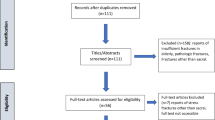Abstract
Stress fractures occur in normal bone due to mechanical overload by cyclic stress increasing the osteoclastic activity, thus facilitating weakening leading to fracture of bones. Long-distance running may lead to stress fractures of the mid- and distal tibia and of the metatarsal bones. Stress fractures to the sacrum are rare. Certain factors for stress fractures in runners have been identified, such as leg–length inequality, a high longitudinal arch of the foot, forefoot varus, and menstrual irregularities in case of female athlete triad. We report on a 22-year-old female runner (usually training 140 km/week) suffering a sacral fatigue-type fracture. The female athlete triad with eating disorders, dysmenorrhea, and osteopenia was ruled out. Sexual hormone blood samples proofed normal values. The diagnosis was performed using magnetic resonance imaging 2 weeks after the onset of buttock pain. A conservative treatment regimen was initiated with strict physical rest for the first 2 weeks, and then gradual increase of physical activity with 60–90 min of daily cycling and moderate 2 × 60 min cross-training. After another 2 weeks time, daily 60–90 min of walking, Nordic pole walking, and moderate strength training two times a week was performed. At 7 weeks running was started, gradually increased to 90 km/week without any pain. A rapid rehabilitation programme after sacral stress fractures involving low impact physical activity, such as Walking and Nordic pole walking, is applicable to female athletes after ruling out the female athlete triad.

Similar content being viewed by others
Reference
Nielsson BE, Westlin NE (1971) Bone density in athletes. Clin Orthop Relat Res 77:179–182
Wolff J (1892) Das Gesetz der Transformation der Knochen. Verlag August Hirschwald, Berlin, pp 1–152
Brukner P, Bradshaw C, Khan KM, White S, Crossley K (1996) Stress fractures: a review of 180 cases. Clin J Sport Med 6(2):85–89
Korpelainen R, Orava S, Karpakka J, Siira P, Hulkko A (2001) Risk factors for recurrent stress fractures in athletes. Am J Sport Med 29(3):304–310
Barrow GW, Saha S (1988) Menstrual irregularity and stress fractures in collegiate female distance runners. Am J Sports Med 16(3):209–216
Johnson AW, Weiss CB, Stento K, Wheeler DL (2001) Stress fractures of the sacrum— an atypical cause of low back pain in the female athlete. Am J Sport Med 29(4):498–508
Baker RJ, Patel D (2005) Lower back pain in the athlete: common conditions and treatment. Prim Care 32(1):201–229
Beck A, Krischak G, Sorg T, Augat P, Farker K, Merkel U, Kinzl L, Claes L (2003) Influence of diclofenac (group of nonsteroidal anti-inflammatory drugs) on fracture healing. Arch Orthop Trauma Surg 123(7):327–332
Matziolis G, Rau HM, Klever P, Erli HJ, Paar O (2002) Modification of human osteoblasts by various analgesics. Unfallchirurg 105(6):527–531
Fredericson M, Ngo J, Cobb K (2005) Effects of ball sports on future risk of stress fracture in runners. Clin J Sport Med 15(3):136–141
Walther M, Reuter I, Leonhard T, Engelhardt M (2005) Injuries and response to overload stress in running as a sport. Orthopade 34(5):399–404
Bono CM (2004) Low-back pain in athletes. JBJS 86:382–396
Kaeding CC, Yu JR, Wright R, Amendola A, Spindler KP (2005) Management and return to play of stress fractures. Clin J Sport Med 15(6):442–447
Burne SG, Mahoney CM, Forster BB, Koehle MS, Taunton JE, Khan KM (2005) Tarsal navicular stress injury: long-term outcome and clinicoradiological correlation using both computed tomography and magnetic resonance imaging. Am J Sports Med 12 [Epub ahead of print]
Delvaux K, Lysens R (2001) Lumbosacral pain in an athlete. Am J Phys Med Rehabil 80:388–391
Paluska SA (2005) An overview of hip injuries in running. Sports Med 35(11):991–1014
Hoch AZ, Pepper M, Akuthota V (2005) Stress fractures and knee injuries in runners. Phys Med Rehabil Clin N Am 16(3):749–777
Kirch K (2005) Female athlete triad. BMJ 330:244–246
Rutherford O (1993) Spine and total body mineral density in amenorrheic endurance athletes. J Appl Physiol 74:2904–2908
Buckwalter JA, Brandser EA (1997) Stress and insufficiency fractures. Am Fam Physician 56:172–182
Major NM (2006) Role of MRI in prevention of metatarsal stress fractures in collegiate basketball players. AJR Am J Roentgenol 186:255–258
Author information
Authors and Affiliations
Corresponding author
Rights and permissions
About this article
Cite this article
Knobloch, K., Schreibmueller, L., Jagodzinski, M. et al. Rapid rehabilitation programme following sacral stress fracture in a long-distance running female athlete. Arch Orthop Trauma Surg 127, 809–813 (2007). https://doi.org/10.1007/s00402-006-0201-y
Received:
Published:
Issue Date:
DOI: https://doi.org/10.1007/s00402-006-0201-y




